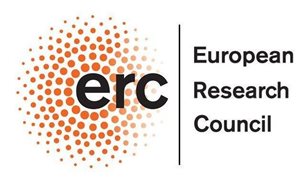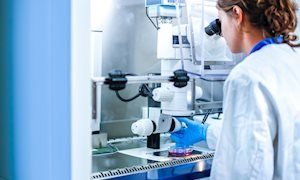
The European Research Council (ERC) is awarding grants for groundbreaking research to Roshan Cools and Peter Friedl, both professors at Radboud university medical center, Nijmegen, the Netherlands. Cools will investigate how brains control behaviour in (stressful) situations, based on a new concept she has developed. Friedl wants to develop a cancer therapy in which multiple sublethal hits are dealt to tumor cells, in the end causing them to die.
Roshan Cools, professor of Cognitive Neuropsychiatry at Radboudumc & Donders Institute for Brain, Cognition and Behaviour
will study substances in the brain that are involved in the cognitive control of behaviour (Balancing brain chemicals for boosting meta-control - CHEMCONTROL). Just before her plane taxies off to the runway, she explains what the innovative project is about: "In science, but also in society, we focus almost exclusively on goal-directed, effortful control, and assign disproportionate value to industriousness, working hard at all time, both physically and mentally. Sometimes that's an effective strategy, but sometimes it's not. The challenge is to know when to work had and exert control and when rather to let go of effortful control and save our energy. In my ERC project, we will study how the brain computes when effortful control is required and when it is not, and how we decide when to prioritize which behavioral strategy. In this context we will focus on behavioural control in the context of stressors. The controllability of those stressors is pertinent in those contexts. If a stressor that you face is controllable, then it's fine to work hard to change the situation. In this case, a proactive, goal-directed strategy is appropriate. But if a stressor is uncontrollable, i.e. unchangeable, then an effortful goal-directed strategy is not a good strategy at all. In that case, it is better to give in to your pre-programmed, hardwired tendencies, that save energy. Meta-control refers to the ability to optimize a dynamic balance between such different strategies depending on environmental demands."
Prefrontal cortex
According to Cools we put too much emphasis on ‘always trying hard’, both in neuroscience and in society. In society this surfaces as a more or less implicit conviction that it is engineerable, makeable. By analogy, prior research in the domain of cognitive control has focused almost exclusively on our ability to exert cognitive effort and direct our action plans towards current goals. Much attention has gone to the roles of the prefrontal cortex and dopamine in the effortful and goal-directed suppression of distractions, impulses and temptations. In this way, learned reaction patterns and impulsive decisions do not get the upper hand and can be suppressed if necessary. The neurotransmitter dopamine plays an important role in this process. In neuroscience, much of the research is therefore focused on the prefrontal cortex and dopamine.
Dopamine and serotonin
Cools: "We reconceptualize the role of the prefrontal cortex. Rather than exclusively serving the ability to exert goal-directed effort, it is more likely important for making decisions about which behavioural strategy is most appropriate given the demands of the current environment In my framework, the prefrontal cortex computes the demands of its environment. If the environment (e.g. a possible stressor) is controllable, then it decides to recruit an effortful, goal-directed strategy that can help us change that environment. In such a case, the prefrontal cortex will send signals to the brainstem to increase dopamine release. This will increase our motivation to try hard to change our environment. By contrast, if the environment (e.g. a possible stressor) is uncontrollable, then it decides instead to recruit an effortless, preprogrammed (Pavlovian) strategy that facilitates automatic biases. An example of such an automatic Pavlovian bias in the context of a stressor is the suppression of mental activity, such as rumination. Indeed, if a stressor is uncontrollable, then such suppression of rumination is adaptive. To this end, the prefrontal cortex will send signals to the serotonin neurons in the brainstem, so that serotonin is released that promotes such preprogrammed Pavlovian biases. Now is the right time to test this novel framework, because of the development of new PET imaging techniques that allow us to measure not only dopamine but also serotonin release in response to stressors.
Two control strategies
Cools will thus gain more insight into the brain mechanisms that control the selection of context-appropriate behavioral strategies in the face of stress. She will test her theory by making use of the newest techniques for brain imaging and brain stimulation. Her group has built a mathematical model that explains how the brain can calculate whether an environmental state, like a stressor is controllable or not, and when it is appropriate to recruit which behavioural strategy. In addition, she has designed experiments that allow her to stimulate or block the different behavioural strategies. Cools: "We can use pharmacological interventions, i.e. pills, to change the concentration of dopamine or serotonin and assess their effects on the propensity of the different strategies in the context of stress. We will also stimulate the prefrontal cortex with focused ultrasound neurostimulation to assess whether we can change the choice process itself."
Personalized health care
The results of this basic brain research will have implications for the treatment of patients. Cools: "If the hypotheses are confirmed, then this will help us tailor existing pharmacological treatment strategies to individual patients and their context. For example, it will advance our ability to predict which patient with which subtype of depression will benefit from dopaminergic or rather serotonergic antidepressant treatment. Furthermore, the results will inspire the development of cognitive therapies that take into account the importance of calculating the controllability of stressors. The trick will be to teach people to know the difference between controllable and uncontrollable stressors, and to act (or not act) accordingly."
Peter Friedl, Professor of Microscopic Imaging of the Cell at Radboudumc
is going to develop a new cancer therapy that kills cancer cells by creating multiple damages that, all together, kill them. Whereas each damage alone will not be deadly, introducing multiple attacks forces the cancer cell to die. "Ever since I studied medicine, I have been fascinated by the immune system and the way cancer often outsmarts the body's important control mechanisms anyway," says Peter Friedl. "In my research, I use advanced microscopy to find the mechanisms by which tumor and immune cells move and to examine how those cells interact in three-dimensional tissue. Recently, we have come to know how moving cytotoxic T cells - CTLs - of the immune system interact with tumor cells and when that doesn’t lead to tumor cell death. In this way, we determined the minimum cytotoxic unit that can be delivered to tumor cells by CTLs. We called that minimum dose the sublethal hit. That’s the foundation of the project for which we have now received the ERC Advanced Grant."
Sublethal hit for tumor cells
In recent years, immunotherapy combined with cytotoxic and molecular therapies has been increasingly used as a treatment for cancer. Despite improving outcomes, this approach does not work for all patients. Toxicity and insufficient efficacy call for further improvement of the therapy. This requires a better understanding of the damage therapies cause to tumor cells and the repair responses they bring into play. Friedl is now proposing a different approach based on recording these sublethal blows. He wants to start combining immunotherapy with novel combinations of cancer therapies at ultra-low, sublethal doses.
Adding more damage
Friedl: "We have shown that cytotoxic T cells can cause non-lethal damage, including to the membrane and DNA of the cancer cell. Often the cancer cell manages to repair the damage and thus survive. If you’re able to increase the damage even further, repair no longer succeeds and the tumor cell will die. I think that these sublethal effects - which we want to elucidate in our research - reveal new vulnerabilities in cancer cells, which we can apply in therapy by combining the sublethal therapies in ultra-low doses and thus destroying the tumor cell after all."
Better tolerated
Friedl's group (Cell Biology) is taking charge of the advanced microscopy in this project, which involves live monitoring of the behavior of tumor and immune cells. Johannes Textor from the Department of Tumor Immunology is adding deep learning and statistical analysis, and Andreas Deutsch from the Technische Universität Dresden is responsible for the mathematical modeling of therapeutic effects and resistance development. Friedl hopes the project will further improve the efficacy of cancer therapy: “By bombarding tumor cells with sublethal attacks, patients will probably be able to tolerate this therapy better and immune cells will continue to function properly."
European Research Council - ERC Advanced Grants for
- Project Roshan Cools: Balancing brain chemicals for boosting meta-control (CHEMCONTROL)
- Project Peter Friedl: From understanding to rational design of next-generation cancer therapies (subLETHAL)
Take a look at Peter Friedl's research tumor cells and a calpain inhibitor.
-
Want to know more about these subjects? Click on the buttons below for more news.
More information
Pieter Lomans

persvoorlichter
Pauline Dekhuijzen

wetenschaps- en persvoorlichter
Related news items

Joint research in regional hospitals New research projects from promotion fund
22 November 2022Four research projects have been honored in the promotion fund of the Radboudumc and four regional hospitals. The research projects, which are a collaboration between CWZ, Jeroen Bosch Hospital, Rijnstate, Sint Maartenskliniek and the Radboudumc will receive a contribution of 240,000 euros.
go to page
The future of laboratory animal research More attention to living conditions of laboratory animals
16 May 2022 On May 9, a meeting took place at the Radboudumc as a result of the launch of the Dutch Transparency Agreement on Animal Testing. The Radboudumc is one of the twenty signatories and has thus committed itself to openly and transparently communicate its vision and policy with regard to animal testing. go to page
Rubicon grants awarded to three RIMLS researchers
19 April 2022Three researchers have received Rubicon funding from NWO/ZonMw. This will enable Elke Muntjewerff, Laura de Vries and Laurens van de Wiel to do research at a foreign research institute for the next two years.
go to page


